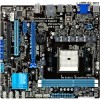Asus F1A75-M LE User Manual - Page 51
DRAM Timing Control, DRAM Voltage [Auto], SB 1.1V Voltage [Auto], 1Vsb Voltage [Auto]
 |
View all Asus F1A75-M LE manuals
Add to My Manuals
Save this manual to your list of manuals |
Page 51 highlights
2.4.6 DRAM Timing Control The sub-items in this menu allow you to set the DRAM timing control features. Use the and keys to adjust the value. To restore the default setting, type [auto] using the keyboard and press . Changing the values in this menu may cause the system to become unstable! If this happens, revert to the default settings. 2.4.7 [+] [-] CPU Offset Mode Sign [+] To offset the voltage by a positive value. To offset the voltage by a negative value. CPU Offset Voltage [Auto] Allows you to set the CPU Offset voltage. The values range from 0.000V to 0.500V with a 0.003125V interval. Refer to the CPU documentation before setting the CPU voltage. Setting a high voltage may damage the CPU permanently, and setting a low voltage may make the system unstable. VDDNB Offset Mode Sign [+] [+] To offset the voltage by a positive value. [-] To offset the voltage by a negative value. VDDNB Offset Voltage [Auto] Allows you to set the VDDNB Offset voltage. The values range from 0.000V to 0.500V with a 0.003125V interval. 2.4.8 DRAM Voltage [Auto] Allows you to set the DRAM voltage. The values range from 1.35V to 2.30V with a 0.01V interval. According to Intel CPU specification, DIMMs with voltage requirement over 1.65V may damage the CPU permanently. We recommend you install the DIMMs with the voltage requirement below 1.65V. 2.4.9 SB 1.1V Voltage [Auto] Allows you to set the Southbridge 1.1V voltage. The values range from 1.1V to 1.4V with a 0.01V interval. 2.4.10 1.1Vsb Voltage [Auto] Allows you to set the 1.1Vsb voltage. The values range from 1.1000V to 1.2000V with a 0.1V interval. Chapter 2: BIOS information 2-15















